Last updated: March 15, 2023
Article
Let’s Hear It for Hosiery!
“‘One can never have enough socks’ said Dumbledore.”—J.K. Rowling (Harry Potter and the Sorcerer’s Stone)
“Imagine a country that flies into space, launches Sputniks, creates such a defense system, and it can’t resolve the problem of women’s pantyhose . . . It was incredible and humiliating to work in such a government.”—Mikhail Gorbachev
OK, we don’t know if that last quote is true or not (we found it on the internet). You got us—we were trying to distract you from the fact that we don’t have a strong NPS-specific thesis about women’s equality and the uniform when it comes to hosiery. But there’s the thing: it is part of the uniform standards, and the NPS Uniform Collection includes socks (don’t worry, they were washed first). Where it gets awkward for us is that our collection manager occasionally brings up the notion of an NPS sock exhibit (and we aren’t always sure she’s joking). Spoiler alert: most of them are brown.
To s-pair us all (get it?), we thought we’d let her have a bit of space here to get it out of her system. Will you indulge her for a few minutes? Thanks in advance.
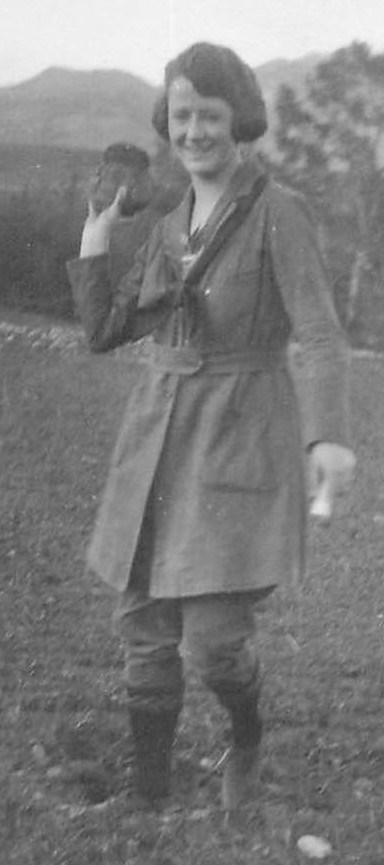
Sock It To ‘Em
Although archeologists have evidence that our Stone Age ancestors wore socks, it was the Greek poet Hesiod who first recorded them in the 8th Century B.C.E.—
Wait! Don’t go! We’ll make her skip ahead in the sock timeline. Moving swiftly on . . .
Socks are not mentioned in the NPS uniform regulations until 1936. Until then, riding breeches were more common than trousers, which were slowly introduced as options for some positions beginning in 1928. In short, no one sees your socks when you’re wearing riding boots, or even shoes with leather puttees (wrap-around shin guards). When the time came, plain brown socks got the nod as the official NPS sock.
Of course, women wore socks in the 1920s and 1930s, either with the prescribed temporary ranger uniform before 1923 or the standard uniform after that date. In most cases, people just didn’t see them. One notable exception was Marguerite Lindsley. She didn’t wear the puttees with her shoes as the temporary ranger uniform prescribed, and her socks are very noticeable. Actually, they were called “sports hose” and were made to wear with knickers (or breeches). These unisex socks were commonly sold in brown or gray with decorative cuffs, although other colors were available.
As skirts were introduced as exemptions to the standard uniform in the 1930s, stockings replaced socks, which weren’t part of the women’s uniform again until 1974—and then only for some women. Wait, what? Did we mean 1943, when the first separate uniform for women was approved? Nope. Definitely 1974. Hmmm, maybe there is more of an equality issue here than we thought. How is that possible? Glad you asked!
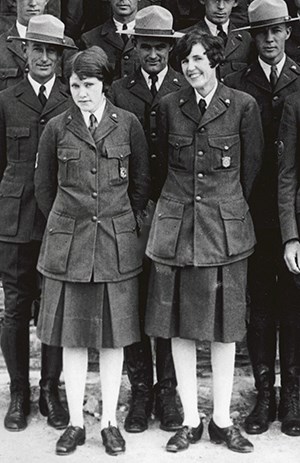
The Trouble with Stockings
In the early 1930s some uniformed women began wearing skirts with the standard uniform coat—revealing their legs for the first time. On duty, women naturally wore the same kinds of stockings to cover their legs that they wore with skirts and dresses when off duty and it was all very unremarkable, right? Well, let’s see.
It’s been suggested that the women in the photo to the left are wearing white opaque stockings but new research challenges that idea. Sheer stockings available to women in the 1930s were made of silk or rayon. By the late 1930s, “mixed hosiery” (with added wool for warmth) was available in colors such as black, “brownbeige,” “sunbeige,” “graydusk,” and “light gunmetal.” It would certainly make sense for the women to choose wool-blend stockings to keep warm, given that the temperature inside Carlsbad Caverns can be as low as 56⁰F.
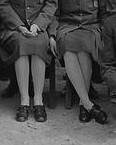
However, we recently found another photograph taken on the same day, with the ranger force sitting rather than standing. Published in a superintendent’s report in 1930, it provides a firm date for the photograph and suggests that their stockings were more neutral in tone. We’re rather sad to kill off this particular myth.
Most uniformed women in the 1930s to 1940s were guides at Carlsbad Caverns, although a handful of women in uniform also worked at Mesa Verde National Park and the Southwestern National Monuments. Photos in the NPS History Collection from that time show them wearing a range of sheer stockings, from neutral to black. This variation is probably behind the call for stockings to be in a “neutral shade” when separate women’s uniform regulations were issued.
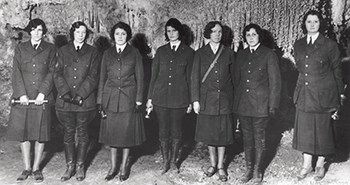
What’s rarely (ever?) talked about regarding the NPS women’s uniform is that requiring women to wear stockings also meant that they had to wear girdles (with stocking clips) or garter belts, otherwise the stockings fell down (self-supporting stockings weren’t invented until the late 1960s). Girdles and garters were part of larger fashion trends in America at the time, and the NPS wasn’t expecting women to do something extraordinary to look the part in their uniforms. And yet, although girdles in the 1930s and 1940s were vastly improved over earlier ones (due to changes in materials used to make them), they were still uncomfortable—at best. Next time you feel uncomfortable in your clothes, imagine adding a girdle. Then imagine wearing it while guiding a tour through, say, a long cave system. Carlsbad’s women guides clearly had exceptional stamina to do their jobs under those circumstances.
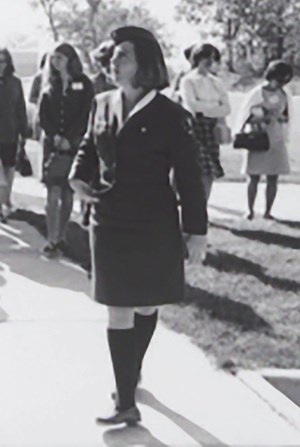
Goodbye Girdles!
The 1960s uniform regulations became more specific, requiring stockings to be “silk, nylon, or similar fiber, sheer mesh, seamless or full fashioned of natural or brown tones.” In addition, within a single park, the shade had to be “reasonably consistent” among the women. (Yeah, good luck with that!). Let’s just say that not all women paid as much attention to this detail of the uniform regulations as perhaps the NPS had hoped.
Pantyhose were invented in the late 1950s and went on sale in 1959. They didn’t become popular until the mid-1960s (thanks to the mini-skirt). They were revolutionary because women no longer needed to wear a girdle or garter belt. They show up in the 1970 uniform standard for the first time, which required women to wear “beige neutral tone” pantyhose or stockings with all classes of uniform (even under the slacks!).
In 1974, the uniform standard became “neutral colored” pantyhose or stockings, worn with the double-knit dress and pantsuit uniforms. In 1977, in greater recognition of the diversity of NPS women, the language changed to “appropriate to the skin color.”
Women wearing the 1974 dress and pantsuit still were required to wear pantyhose, but those authorized to wear the “women’s traditional uniform” could wear plain or ribbed dark brown socks with the choice of ankle, calf, or knee length, as appropriate. And just like that (well, about 40 years later) women’s socks were back!
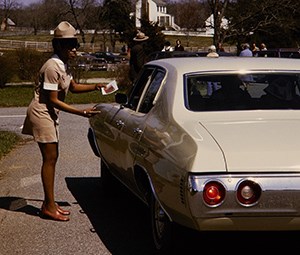
Socks as Symbols of Equality
OK, we accept that socks are just a footnote in the history of NPS women (sorry, we couldn’t resist that one), but hear us out. Do you wear pantyhose with your hiking boots? Do knee-highs keep your feet warm enough to be outside all day? Perhaps socks shouldn’t be dismissed quite so quickly.
Ultimately, socks came back to NPS women when they could once again wear what NPS men wear. “Skin tone” hosiery and skirts remain an option, but brown dress socks now accompany both men and women’s uniforms. Various styles of brown boot socks and hiking socks also provide warmth and cushioning for those working in the field (and even sometimes in cold offices). Most of us put on our socks every day without realizing that for more than 40 years, socks weren’t something that NPS women could wear. Happily, women have now been wearing socks with their uniforms for as long as they weren’t—and doesn’t that just knock your socks off?
Explore More!
To learn more about Women and the NPS Uniform, visit Dressing the Part: A Portfolio of Women's History in the NPS.
This research was made possible in part by a grant from the National Park Foundation.
